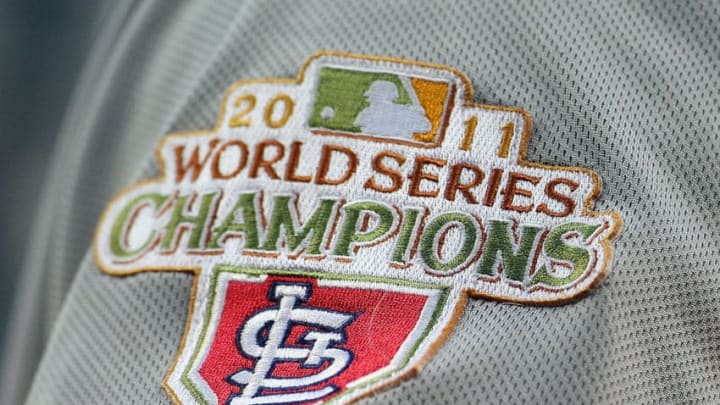John Mozeliak made two critical trades in July of 2011 which helped propel the struggling St. Louis Cardinals to their 11th World Championship. The trades didn’t make an immediate impact, but they paid off during the September chase for the postseason.
Coming out of the All-Star Break on July 15, 2011, the St. Louis Cardinals found themselves tied with the Milwaukee Brewers for first place in the NL Central. Nevertheless, with only a 49-43 record, the Cardinals weren’t exactly cooking and were facing several issues with their roster.
The Cardinals co-ace, Adam Wainwright, had Tommy John surgery during the off-season and would miss the entire 2011 season. Ryan Franklin had struggled in the closer’s role and would be released in June. In fact, the whole bullpen would be reworked before the end of the season, with only Mitchell Boggs and Jason Motte surviving to the end of the season.
Additionally, Ryan Theriot, who had been traded to the Cardinals to be the primary shortstop in the off-season, was struggling at the position and would commit 17 errors in 2011. Colby Rasmus, considered to be a five-tool prospect and was expected to be the next great Cardinal center fielder, was struggling at the plate, hitting .194 since May. By July, Rasmus, who had been feuding with Manager Tony LaRussa, was on his way out.
Enter General Manager John Mozeliak, who would engineer the two trades which would resolve these issues and eventually propel the Cardinals to the World Series.
The First Trade
On July 27, Mozeliak executed a four-for-four trade which involved the unhappy and struggling Rasmus, left-handed relievers Trever Miller and Brian Tallet, and starter P.J. Walters to the Toronto Blue Jays. In return, the Cardinals received, right-handed starter Edwin Jackson, left-handed specialist, Marc Rzepczynski, right-handed reliever Octavio Dotel, and outfielder Corey Patterson.
The trade moved Jackson into the starter’s role and allowed the Cardinals to move the reliable and versatile Kyle McClellan, who had taken Wainwright’s spot in the rotation, back into the bullpen. Jackson would be a steady rotation piece for the rest of 2011, throwing for 78 innings with a 5-2 record and a 3.58 ERA.
Rzepczynski and Dotel both helped solidify the bullpen. The 26-year old Rzepczynski had a 3.97 ERA after arriving with the Cardinals but was dominant in October. He allowed only one earned run in nine appearances during the NLCS and WS. Dotel, meanwhile, had a 3.28 ERA in 29 games after arriving from Toronto and allowed only three earned runs in 12 appearances during the postseason.
Jon Jay replaced Rasmus in center field and provided a steady defensive glove. Jay also had a slash line of .297/.344/.424, 10 home runs, and an OPS+ of 112 in 159 games during 2011.
The Second Trade
Just before the non-waiver trade deadline on July 31, Mozeliak sent AA outfielder Alex Castellanos to the Los Angeles Dodgers for shortstop Rafael Furcal. The acquisition of Furcal allowed the Cardinals to tighten up their defense going into the stretch run of 2011, and move Theriot to a bench/pinch-hitting role.
The switch-hitting Furcal hit a slash line of .255/.316/.418 with seven home runs and 16 RBI in only 50 games. However, it was during the stretch run in September that Furcal was at his best. In 23 games, he had .275 BA, hit four homers, six doubles, and eight RBI with an OPS of .819. Additionally, he became a reliable leadoff hitter for the Cardinals, drawing 17 walks after he arrived.
But it was mainly the 33-year old’s range at shortstop which help the Cardinals during the stretch run of August and September. After he arrived in St. Louis, his Rtot/yr was 2, compared to Theriot’s -16.
After the Trades
The effects of the two trades weren’t felt immediately. The Cardinals had gone 13-13 in July and in August, they went 15-13, falling behind the NL Central leaders, Milwaukee Brewers by 8.5 games. Worse, the Cardinals seemed to have fallen out of the Wild Card race also, trailing the Atlanta Braves by 10.5 games as late as August 24.
More from St Louis Cardinals History
- Cardinals: The best Silver Slugger performances at each position.
- The St. Louis Cardinals are in rare company with this free agency stat
- What Happened to the 2011 St. Louis Cardinals? Matt Holliday Edition
- The St. Louis Cardinals avoided disaster with Jason Heyward
- St. Louis Cardinals: Stan Musial’s time in the Navy
But in September, the Cardinals began their push for the postseason by going 18-8 for the month. They didn’t catch the Brewers, but rapidly closed the gap with the Braves, who went 9-18 for the month. The Cardinals clinched the wild card berth on the last day of the season and went on to beat the Phillies in the NLDS and the Brewers in the NLCS. Of course, we all remember what happened in the World Series, especially game 6.
John Mozeliak often gets criticized for trades he doesn’t make at the trade deadline. However, in July 2011, he made two critical trades which propelled the St. Louis Cardinals to their 11th World Championship.
Richard Justice of MLB.com recognized Mozeliaks two trades as the 8th and 9th trades which won World Series in the last decade. “Sometimes it’s the smallest trades that make the biggest difference,” said Justice of the two trades.
By improving the rotation, restructuring the bullpen, and shoring up the defense, John Mozeliak made the moves he needed to make in 2011. One trade was bold and the other was hardly noticed when it was made. However, both helped lead the St. Louis Cardinals to their 11th World Series title.
